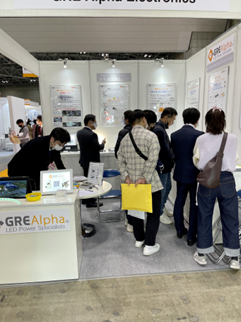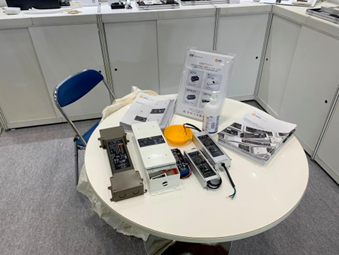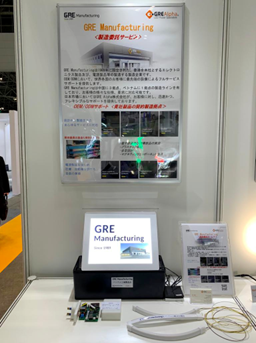GRE Alpha is Geared Up for LightFair 2023
May 16th 2023GRE Alpha is Geared Up for LightFair 2023
GRE Alpha, a leader in the field of lighting controls and drivers, will be exhibiting LED Dimmers and drivers at LightFair 2023 at the Javits Center in New York City. The trade show takes place May 23-25, with the conference running from May 21-25. At booth no. 1328 on the third level, attendees can experience GRE Alpha's newest products firsthand. “We are excited to be a part of this year's LightFair as it brings together professionals from all across the globe," said Richard Fong, Executive Director at GRE Alpha. The event, which drew over 10,000 people from 63 countries in 2022, is expected to be even bigger and better in 2023.
GRE Alpha is proud to demonstrate products featuring compatibility with some of the world's leading partners, such as Casambi, Tuya, and EnOcean. These exciting collaborations appeal to a global audience and offer customers unprecedented access to innovative solutions that exceed global safety and efficiency standards. We look forward to continuing our work with these partners and creating an even greater network in the years to come.
Here are some of the featured products for 2023:
- Model GLD-DIM-TW-CB2. - 2-channel dim-to-warm / tunable white, CC output, Casambi BLE-based dimming module. Users download the Casambi app to their iOS or Android device to control all their enabled COB light fixtures
- Model SLD-DIM–CB2-UL - 2-channel, multi-function, CV output, Casambi BLE-based dimming module that can be set for tunable white, dim to warm, and static dimming via the Casambi app, for use in linear tape/strip lighting applications
- Model SLD-DIM-CB5 - 5-channel, RGBWW, CV output, Casambi BLE dimming module for use in RGB and tunable white linear tape/strip lighting applications
See GRE Alpha’s product catalogs or contact their team for more information.
GRE Alpha is honored to be a regular guest at LightFair International, and we can’t wait to demonstrate our cutting-edge products. The company's LED dimmers and drivers are engineered to bring efficiency and precision to lighting systems by providing flexible control options while reducing energy consumption and maintenance costs. Their suite of LED power supplies and controllers is designed for use in commercial applications such as offices, schools, hospitals, retail stores, and more.
About GRE Alpha
GRE Alpha® Electronics, Ltd. specializes in the design and manufacturing of solid-state lighting power supplies and lighting control accessories, which are the lifeblood of indoor and outdoor LED lighting systems. Their superior performance products are the power behind LED lighting systems. GRE's unique modular approach allows its dimming modules and drivers to be used in either new or existing installations. For more information, visit GREAlpha.com. Follow us on LinkedIn: GRE Alpha.
About LightFair
LightFair, the world’s largest architectural and commercial lighting trade show and conference, is owned by the International Association of Lighting Designers (IALD) and the Illuminating Engineering Society (IES). The event is produced and managed by International Market Centers. For more information, visit LightFair.com. Follow LightFair on Facebook, Twitter @LightFair, Instagram @LightFair_international, LinkedIn and YouTube. To stay up to date on lighting industry news leading up to LightFair, visit the LightFair Blog at www.LightFairblog.com.
What Are Dimmable LED Drivers?
May 12th 2023What Are Dimmable LED Drivers?
The time is now for LED lighting—businesses, organizations, and municipalities worldwide are switching to LEDs to have maximum control over their lighting operations.
One of the most common and sought-after lighting controls is dimming. However, dimming LEDs requires a dimmable LED driver.
Below, we’ll highlight what dimmable LED drivers are, some of their requirements, and why you should use them.
What is a Dimmable LED Driver?
An LED driver is a device that regulates the amount of power sent to an LED or a string of LEDs. There are two primary types of LED drivers: Dimmable and non-dimmable.
The primary advantage of dimmable LED drivers is that they give you complete control over the luminaire and avoid using too much light when it isn’t needed.
Diving deeper, there are two types of dimmable LED drivers:
- Trailing edge dimmable drivers (also known as ELV drivers)
- Leading edge dimmable drivers (also known as TRIAC drivers)
Trailing edge dimming is most commonly used with electronic drivers and won’t result in a rush of voltage to the luminaire. Conversely, leading edge dimming is associated with incandescent bulbs and will produce a rush of voltage to the luminaire.
Many dimmable drivers give you the option to choose between two types of dimming—for example, the XLA Series from GRE Alpha.
LED Dimmable Driver Requirements
LED drivers can facilitate dimming and color sequencing for their connected LEDs—however, not all drivers work with RGB color schemes. For this practice, the dimmable external drivers will often require some sort of external dimmer or any other dimming control device.
In many cases, you’ll be able to find applicable external dimming devices compatible with the driver on the data specifications sheet.
Both constant-current and constant-voltage LEDs and drivers can be made with intrdimming capabilities built-in.
What are the Benefits of a Dimmable LED Driver?
Choosing LED drivers with dimming capabilities provides several advantages for building managers and lighting operators. Here are three of the biggest benefits.
Aesthetics and Mood Setting
The sheer control provided by dimmable LED drivers allows building managers and operators to create the exact aesthetic or mood they’re looking for.
For example, hotels often require a certain ambiance with their lighting to create a welcoming and smooth environment indicative of the luxurious or elegant nature of the hotel.
Dimmable LED drivers also allow managers to control lighting at different times of the day. This is a big help in a work environment—lights can be dimmed during the day and turned up higher during a night shift to make it easier to see.
Energy-saving
The ability to dim your LED lights helps conserve a lot of energy. Instead of running LED lights at full power all the time, dimmable LED drivers give you control over your power consumption. You can dim the lights when not as much is required and turn them up whenever necessary, such as during peak work hours.
In fact, the amount of energy saved is directly proportional to the wattage chosen.
For example, if you dim the light down to 50%, you’ll actually be using half the amount of power.
Prolonged Lifespan
With the ability to dim your LED lights comes a prolonged lifespan for your LED investments.
When you factor in the drivers and the luminaires themselves, LED lighting can be an expensive investment—it makes sense to protect them and keep them for as long as possible. Dimmable LED drivers help regulate the flow of electricity to an LED light and prevent damage to its internal components.
Find High-Quality Dimmable LED Drivers From GRE Alpha
If you’re setting up dimmable LEDs, we can help. Browse the GRE Alpha catalog for our collection of dimming modules and dimmable LED drivers today.
New LED Lighting Control Trends Unveiled by Steady Catalog Interest
The market for LED control systems is quickly evolving to keep up with changing energy regulations, consumer expectations, and technological developments. Smart dimming, quality components, energy efficiency, and reliable manufacturing are all top of mind.
By analyzing interest in our catalogs and talking with our distributors, we can tell a lot about the latest innovations in LED power supplies and controllers. Our field team interacts daily with both long-time customers and professionals we’ve met at events like Japan's Lighting Fair 2023 and North America's CES. They not only share our products but gain sharable insights into current trends and market conditions.
We’ll unpack some of the latest emerging LED control trends indicated by our team so you can best shape your purchasing strategies. Read on to discover what could lie ahead.
Overview of LED Driver Trends
As the lighting world continues to evolve, LED drivers and dimmers have become increasingly important components that guide the effectiveness of LED systems. Smart dimming has provided remarkable opportunities for LED solutions to become more energy-efficient and customizable. From brands like Xiacato’s wide selection of lighting controls to Casambi’s complete portfolio of hardware automation solutions, the contemporary market is awash with innovative products that transform how lighting is deployed in modern design. As we move deeper into 2023, more creative ways to seamlessly meld technology and components will continue evolving.
LED Dimmer Technologies and Benefits in the Age of IoT
The modern LED driver and dimmer technologies are ushering in a new era of efficiency and convenience. LED drivers and dimmers can connect to the Internet of Things (IoT), allowing for effortless control of lighting levels from anywhere in the world. Moreover, these technologies also allow for easy installation, decreasing the complexity often associated with adjusting lighting systems. This streamlined setup can help designers save significant time on projects and lower their energy costs over time. The next generation of LED dimming technologies is here to make life easier!
The DALI Alliance, also known as the Digital Illumination Interface Alliance, has long been on the cutting edge of IoT. Building on the long-established benefits of DALI, the DALI-2™ certification program promises significantly improved interoperability along with more features and functions, including sensing and data gathering. Meanwhile, D4i™ enables DALI for intelligent, IoT-ready luminaires. They have also introduced different connectivity options over wireless and IP-based networks and added the new DALI+™ brand.
Customers Seek Benefits of Using LED Drivers and Dimmers
LED lighting controls offer numerous benefits for designers and end users. Buyers look for LED drivers and dimmers to significantly improve overall design and operation. Quality drivers regulate current flow to the lighting, influencing brightness, color consistency, and power consumption.
Meanwhile, dimmers allow users to control the light intensity with ease–both manually and via remote command–allowing users to customize the luminosity of their LED lights based on their needs at any given time. Utilizing technology like Tuya WiFi, EnOcean, Casambi, and Xicato BLE products enables end users to experience a comprehensive yet intuitive, user-friendly experience when it comes to controlling various aspects of their lighting systems. These technologies allow users multiple energy-saving options while creating exceptional ambient light scenes that bring specific spaces to life.
Industry Insights - What Professionals Need to Know About New LED Controls
OEMs, procurement managers, designers, and other professionals in the LED industry are looking for new, cutting-edge controls and solutions to stay ahead of the competition.
When considering a dimmer or driver manufacturer, we recommend assessing several key criteria:
- Manufacturing process
- Testing and certifications
- Product Compatibility
- Delivery Lead-time
- Ease of Installation
- Quality of Customer Care
- Overall reliability
- Warranty
With the right LED driver and dimmer information, you can ensure that your systems come together - with no added inconvenience or worry. At GRE Alpha, we strive to provide our customers with solutions that meet their needs not only today but also in terms of long-term reliability and satisfaction.
We’re excited to provide a reliable source of products that support our clients and continue innovating with the changing LED lighting environment.
Here are some of the featured products for 2023:
- Model SLD-DIM–CB2-UL - This is a 2-channel, multi-function Casambi BLE-based dimming module that can be set for tunable white, dim to warm, and 100% dimming via the Casambi app.
- Model SLD-DIM-CB5 - A 5-channel, RGBWW Casambi BLE dimming module for use in RGB and tunable white strip lighting applications.
- Model SLD-DIM-WF2-TW - A 2-channel, multi-function Tuya Wifi/BLE-based dimming module that enables easy IoT integration and is easily controlled by smart lighting/IoT technologies, such as Amazon Echo.
The catalog also includes some of the products we’re known for, including the Easy Install SLD60, our EnOcean dimming modules, LED dimming modules, and more.
Learn more about our innovative products in the 2022-2023 GRE Alpha product catalogs.
Partnerships Lead to Successful Event for GRE Alpha & GRE Manufacturing
GRE Alpha and GRE Manufacturing (GRE-M) brought their goods and services to Japan's Lighting Fair 2023. Interest among the attendees in supporting carbon-neutral efforts continues to grow.
Partnerships like the one between Marubeni Systems (MSYS) and GRE Alpha have opened new avenues for energy harvesting systems that self-generate power from movement, light, heat, and other sources. Such systems are not just highly safe and durable, but also offer improved power efficiency and operational efficiency. This makes them an attractive option for a variety of uses. With the continuing spread of IoT devices utilizing low-power wireless communication, the market demand is expanding.

Attendees gather at the GRE Alpha booth.
GRE Alpha was supported by other partnerships as well. Some of these products include:
- Dimming modules (DALI-enabled, PWM tunable white, etc.)
- IoT/wireless smart lighting solutions
- Tuya WiFi, EnOcean, and BLE products (both Casambi and Xicato)

GRE Alpha products, such as dimming modules and power supplies, on display at the event.
Richard Fong Director at GRE Alpha and GRE Manufacturing noted, “In contrast to other shows, this was a joint exhibition of GRE Manufacturing and GRE Alpha. We displayed not only GRE Alpha’s dimming modules and power supplies but also showcased GRE Manufacturing’s capabilities. As an electronics manufacturing services company (EMS), GRE Manufacturing offers competitive contract manufacturing services for customers in our facilities in Vietnam and China.”
The use of GRE Alpha's LED power supplies and dimming modules with built-in receivers for wireless standards such as BLE or EnOcean to control lighting systems can provide a range of benefits. Not only does this system enable users to easily turn off lights with the push of a switch, but it also minimizes energy consumption by using energy-harvesting wireless technology.

The capabilities of GRE Manufacturing were also on display at the event.
Event attendees were especially impressed by the manufacturing service, BLE solutions, and DALI modules. However, the chance to meet with and talk to valued customers was the most crucial part of the event.
GRE Alpha and GRE Manufacturing value all our partners who share our same mission: To create innovative products and solutions in the LED lighting space.
Learn More:
GRE Alpha and GRE Manufacturing Partner with Marubeni Information Systems
February 14th 2023GRE Alpha and GRE Manufacturing Partner with Marubeni Information Systems
GRE Alpha and GRE Manufacturing are excited to announce a partnership with Marubeni Information Systems (MSYS) for the future distribution of GRE Alpha products and support of GRE Manufacturing services. The collaboration originated in Japan and ASEAN region, but given the reach of the two firms, the impact will be global.
Marubeni Information Systems delivers high-value solutions and services, serving a wide variety of needs for various clients. They provide leading-edge technologies that help differentiate their clients with extensive knowledge of different industries, including:
- Manufacturing
- Distribution
- Services
- Finances
They’re also a one-stop shop for system consulting, design, construction, operation, and maintenance. These attributes support GRE Alpha’s mission: Using innovation to provide a seamless experience in lighting system integration and set-up—without compromising on reliability or performance.
MSYS currently distributes GRE Alpha’s EnOcean, BLE, and ZigBee products. The collaboration supports current and future wireless lighting control products. It also gives global OEM/ODM contract manufacturer GRE Manufacturing access to Marubeni Information System’s current customer network. That pairing will open the door for business opportunities providing turnkey design & manufacturing services.
As always, GRE Alpha is looking forward to the future with this new partnership.
You can find more information about GRE Alpha’s partners and Marubeni Information Systems on their website: Marubeni Information Systems